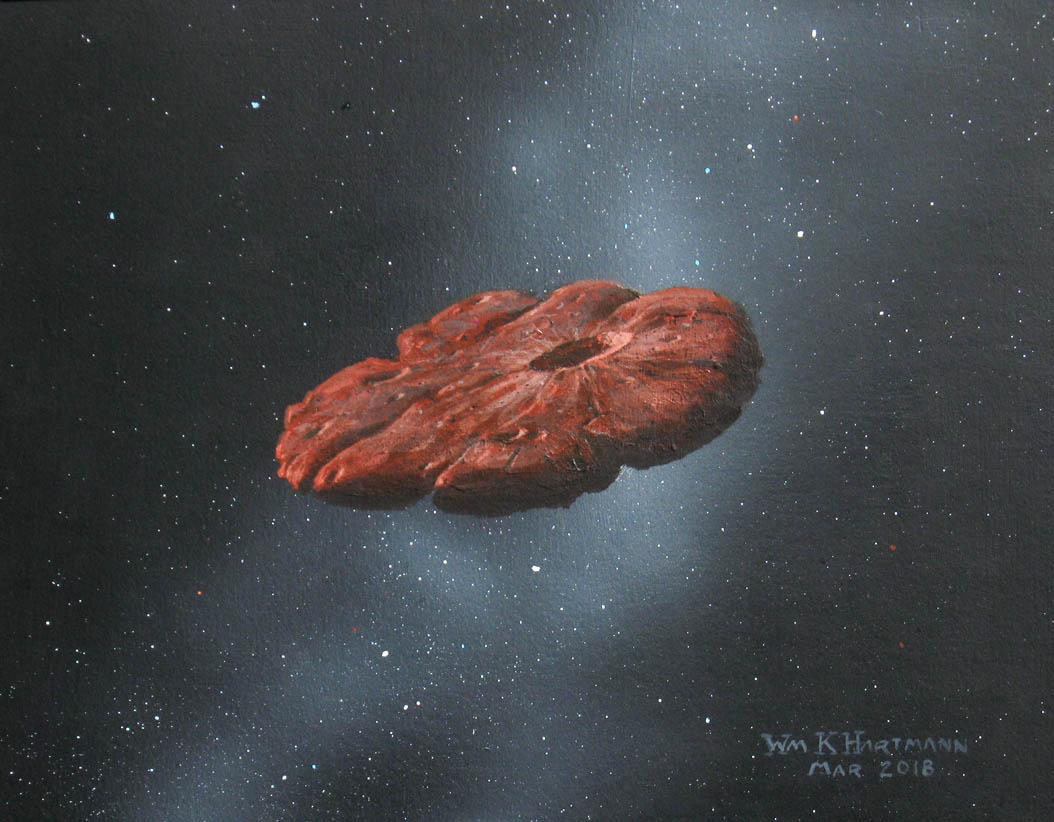Interstellar object 'Oumuamua is a pancake-shaped chunk of a Pluto-like planet
The strange tale of our first interstellar visitor keeps getting weirder.
The first known visitor from interstellar space, 'Oumuamua, was likely a pancake-shaped chip off a Pluto-like world, researchers say.
These findings may shed light on the stuff a new class of planet, an exo-Pluto, is made of, scientists added.
Astronomers first detected the mysterious visitor named 1I/'Oumuamua — meaning 'scout' or 'messenger' in Hawaiian — in 2017. 'Oumuamua's speed and trajectory revealed it originated outside the solar system, making it the first known interstellar object.
Related: 'Oumuamua: Solar system's 1st interstellar visitor explained in photos
The second known interstellar object, 2I/Borisov, was detected in 2019. Borisov was very clearly a comet, spewing out gases and possessing a composition much like comets long seen in the solar system.
An interstellar comet? Asteroid? Something else?
In a number of key ways, 'Oumuamua resembled a comet. For example, scientists could not explain its movements through space by the force of gravity alone. This suggested 'Oumuamua was jetting out gas from its sunlit side that was pushing it like a rocket, study co-author Steven Desch, an astrophysicist and planetary scientist at Arizona State University in Tempe, told Space.com.
However, if 'Oumuamua was a comet, it was unlike any previously seen in the solar system. It lacked any detectable escaping gas, unlike the big tails typically spotted streaming from comets. In addition, its shape — resembling either a cigar or a pancake — was unlike any known comet. Moreover, the rocket-like push seen from 'Oumuamua was stronger than what researchers expected from comets.
Breaking space news, the latest updates on rocket launches, skywatching events and more!
All these bizarre features 'Oumuamua's even led some researchers to speculate that it had alien origins.
"Everybody is interested in aliens, and it was inevitable that this first object outside the solar system would make people think of aliens," Desch said in a statement. "But it's important in science not to jump to conclusions."
Now scientists find 'Oumuamua might not be a piece of alien technology, but a chip off a Pluto-like world.
A strange new object
Researchers speculated that 'Oumuamua was not made largely of water ice like known comets, but perhaps of other kinds of ices. They calculated how quickly such ices would sublimate — convert from a solid directly to a gas — as 'Oumuamua flew by the sun, and the rocket-like push it would get from these escaping gases.
The scientists also noted some ices are far more reflective than often assumed. If 'Oumuamua was made from these shiny ices, it might be smaller than previously estimated based on the light that astronomers detected from it. A tinier size for the interstellar visitor would mean any push from sublimating gases would have a larger effect than usually seen with comets, helping explain the unexpected speed with which it zipped away from the sun.
The researchers found one ice in particular — solid nitrogen — could explain all of 'Oumuamua's features and behavior. Solid nitrogen ice is seen on the surface of Pluto and Triton, suggesting this interstellar visitor could be made from the same material. "It was very satisfying to refine our calculations and see everything fall into place," Desch said.
Any nitrogen gas escaping from 'Oumuamua would have proven very difficult for astronomers to detect with the telescopes used to monitor it. "In essence, there was a tail like one would expect for a comet, it is just that because of what it is made of, we didn't detect it," study co-author Alan Jackson, an astrophysicist and planetary scientist at Arizona State University in Tempe, told Space.com.
An interstellar flapjack
These new findings suggest 'Oumuamua was shaped more like a pancake than a cigar. It may also be smaller than previously thought — just 147 by 144 by 24 feet (45 by 44 by 7.5 meters) in size when astronomers first detected it. In comparison, prior estimates suggested 'Oumuamua was about 1,300 feet (400 m) long.
The researchers suggested that 'Oumuamua likely wasn't flat when it first entered the solar system. However, the light from the sun ultimately eroded it to a sliver, wearing away more than 95% of its mass.
"The same thing should happen with water-ice comets, but at a much smaller level," Jackson said. Water ice sublimates much slower than nitrogen ice, Desch explained. In addition, Jackson noted 'Oumuamua may have stayed together as one piece as it sublimated because it was made all of the same material — in contrast, most comets in the solar system are mixtures of rock, water ice and other ingredients, "so they tend to evaporate unevenly. This is partly why comets often break up when they pass very close to the sun."
'Oumuamua origin: How our mysterious interstellar visitor may have been born
These findings suggest interstellar objects such as 'Oumuamua may give us our first view of a hitherto unknown type of planet — an exo-Pluto. All in all, 'Oumuamua may be the first known sample of an exoplanet brought into the solar system, the researchers said.
"The thought that what we saw could be a chunk of an actual exoplanet is thrilling," Desch said.
Piece of an exo-Pluto
Based on 'Oumuamua's speed and trajectory, the researchers suggested this fragment of nearly pure nitrogen ice was slung away from a young star system about 400 million to 500 million years ago, possibly from the Perseus arm of the Milky Way. When it comes to what to call this potentially new class of objects, Desch suggested exo-Pluto fragments or Pluto-like fragments, whereas Jackson suggested nitrogen-ice comets.
The scientists calculated the rate at which cosmic impacts would have knocked chunks of ice off the surfaces of Pluto and similar bodies over the course of the solar system's history. They estimated such collisions might have generated 100 trillion fragments, about half of which are water ice and the other half nitrogen ice. All in all, "about 1 in 1,000 comets in our solar system must be objects like 'Oumuamua," Desch said. One such example may be the comet C/2016 R2, discovered in 2016, he noted.
The researchers also calculated the chances that a nitrogen-ice comet from another star would reach our solar system. Their findings suggested "the outer reaches of a lot of planetary systems look very much like our own," Jackson said. "It is difficult to get information about the outer reaches of exoplanetary systems with the methods that we usually use to look for planets, so this gives us a unique way to get a sense of what exoplanetary systems are like."
Future telescopes such as the Vera Rubin Observatory in Chile could help regularly scan huge swaths of the sky and detect even more interstellar objects to learn more about them. In addition, "there has also been some work on concepts for space missions that could intercept a future object like 'Oumuamua," Jackson said. "That to me is an incredibly exciting prospect — an up close look at something that originated from outside our solar system."
The scientists detailed their findings online March 16 in a study divided into two papers, which you can find here and here, in the Journal of Geophysical Research: Planets, and at the Lunar and Planetary Sciences Conference.
Originally published on Space.com.

Charles Q. Choi is a contributing writer for Space.com and Live Science. He covers all things human origins and astronomy as well as physics, animals and general science topics. Charles has a Master of Arts degree from the University of Missouri-Columbia, School of Journalism and a Bachelor of Arts degree from the University of South Florida. Charles has visited every continent on Earth, drinking rancid yak butter tea in Lhasa, snorkeling with sea lions in the Galapagos and even climbing an iceberg in Antarctica. Visit him at http://www.sciwriter.us


